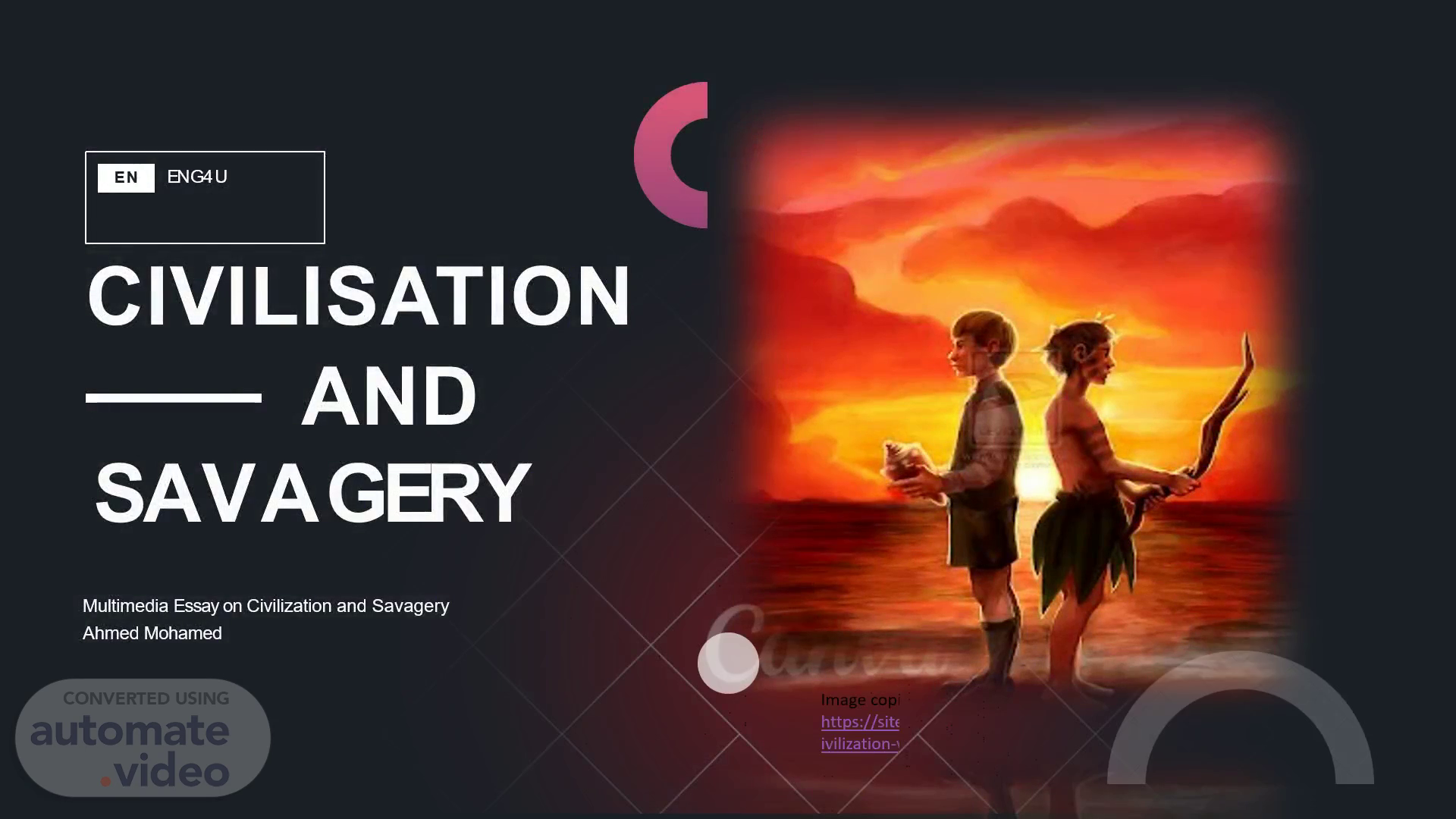Scene 1 (0s)
E N G 4 U. E N. CIVILISATION AND S A V A G E R Y Multimedia Essay on Civilization and Savagery Ahmed Mohamed.
Scene 2 (13s)
Introduction. Civilization is the epitome of human and social development while savagery, destroys hope and humanity. The contest between civilisation and savagery in "The Lord of Flies" demonstrates that, unlike civilisation which promotes hope and order, savagery, which takes place in the absence of civility, destroys hope in humanity through oppression and disorder. This is supported by Radojević when he explains that "Ralf represents civilisation and the rule of reason while Jack symbolises the voice of instincts and the wildness of human nature" (145)..
Scene 3 (38s)
Fauget Art School. F A S. Onset of Savagery Jack's refusal to carry out his duty of the signal fire, leading to the loss of the opportunity to leave the island, symbolises the onset of savagery Slipping of Civility The slipping away of civilisation takes place when Jack refuses to undertake his duty of looking after the fire, signalling an end to civility Proof Golding demonstrates the savagery nature of Jack and how he refuses to look after the fire. He enables the audience to understand the savagery of nature and how it creates disorder by stating, "The world that understandable and lawful world was slipping away. Once there was this and that, and now—and the ship had gone" (Golding 79)..
Scene 4 (1m 16s)
Savagery in the text, takes place when civility slips away. Savagery, which creates lawlessness, destroys the societal barriers critical to keeping a civilised community together As stated by Amelia, in distinguishing the conflict between savagery and civilisation and their relation to the absence of society's restraints, she says that society's restraint "plays a significant role to suppress the instinctual drives and construct a mentally healthy, civilised man" (Amelia). Unlike civility, which reinforces order through societal restraints, savagery removes this restraint, making a setback to attaining civilisation. This creates disorder due to the lack of restraints..
Scene 5 (1m 49s)
How Savagery Destroys Hope in Humanity. Savagery, which Jack represents, embodies oppression, which destroys hope in humanity. Jack, as the representation of savagery in the novel, engages in bullying the island's inhabitants and oppresses them. Jack, representing savagery, mistreats the animals. He commands them, telling them, "Fear can't hurt you any more than a dream. There aren't any beasts to be afraid of on this island…. Serve you right if something did get you, you useless lot of cry-babies!" (Golding 71). The island's inhabitants' oppression leads to the spread of savagery and destroys hope in humanity.
Scene 6 (2m 23s)
Civility, Order and Hope. Civility in "The Lord of Flies," is represented by Ralph. Ralph, ensures law and order by making the rules which guide the conduct of the inhabitants during their social interactions. Ralph advocates for rules when he opines, "We ought to have ore rules. Where the conch is, that's a meeting. The same up here as down there" (Golding 42). In this statement, Ralph elaborates on the need to have more rules to guide their lives on the island. Civilisation, which embodies law and order, binds the members of the society and helps them interact while upholding respect towards one another. This introduces the members to a restraint which helps inspire hope among members . By ensuring that they keep the fire burning, this helps in connecting them to the lost civilisation, thereby inspiring hope..
Scene 7 (3m 4s)
Golding provides a contrast between civilization and savagery through the characterization of Jack and Ralph. Golding demonstrates how the absence of civilization provides a perfect opportunity for lawlessness to set in as part of human nature. When savagery kicks in, good deeds cease to exist, lea ding to oppression and loss of hope..
Scene 8 (3m 25s)
Works Cited. Amelia, Fransisca . Civilisation versus Savagery in William Goldingâ €™ s Lord of the Flies . Diss. Universitas Gadjah Mada , 2014. Golding, William. Lord of the Flies: Casebook Edition . Penguin, 1987 Radojević , Ivona Z. " Civilisation and savagery in William Golding's Lord of the Flies." Reči (Beograd) 9.1 (2017): 145-161..
Scene 9 (3m 45s)
T h a n k. y o u.
